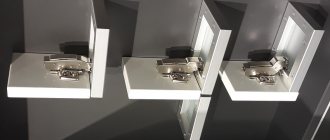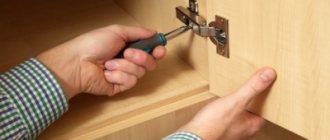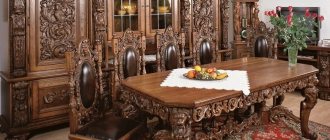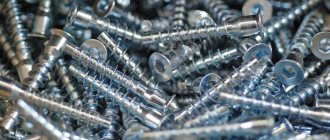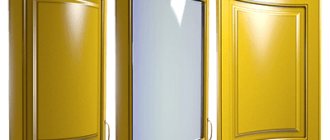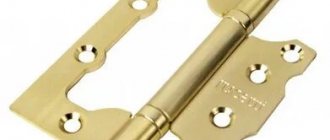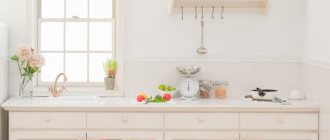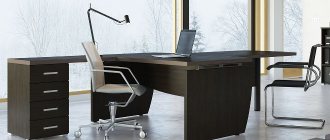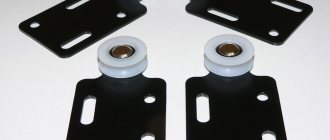2019-04-28
Author: Belfan
Issues discussed in the material:
- How do furniture hinges with closers work?
- What are the types of furniture hinges with closers?
- How to install furniture hinges with closers
Today, furniture hinges with closers have turned from a luxury item into a common, and at the same time, very important element of everyday life. They are convenient, and their relatively low price makes them accessible to many. However, the main advantage of such devices is that you get rid of constantly slamming cabinet doors and can protect yourself from minor household injuries.
Peculiarities
The main difference between furniture hinges with a closer is the silent and smooth closing of the door leaves. Each product is equipped with an auxiliary device (closer or shock absorber), which allows you to fix the furniture facade to the body carefully, without slamming. The hinge body contains a spring filled with oil, gas or a viscous medium. Depending on the type of loop application, the fittings can be overhead, semi-overlay, or internal. Undoubted advantages of the design with a closer:
- silent and smooth closing of doors. A slight force is enough for the sash to close neatly. In this case, the door does not hit the furniture body;
- increasing the service life of furniture. It is impossible to slam a door equipped with a closer, which prevents mechanical damage to the door leaf;
- the fittings can withstand significant loads, so massive facades can be installed on furniture products. The closer is securely secured inside the hinge with screws or latches;
- The hinge mechanism can be adjusted to ensure a tight fit between the door and the body. No professional tools are required for adjustment;
- the filling of the cylinder with the spring is isolated by a fuse against the leakage of oil or working fluid, so if the hinge fails, the mixture does not fall on the furniture surface.
By adjusting the closer valves, the closing speed of furniture doors is increased or decreased. With a little force (push the door slightly enough), the door closes under its own weight. When the doors are closed, the liquid covering the spring flows into the closer capsule sleeve. The narrowing (expansion) of the fluid outflow channel causes the piston to move. Adjusting the valves sets the speed of movement of the piston element and controls the time for complete closing of the doors.
How to choose furniture hinges with closers
Unfortunately, there have been no global audits of manufacturers of furniture hinges with closers, which means it is simply not possible to name the best and worst brands of all those on the market. According to GOST, furniture hinges and guides for roll-out drawers are considered to be of high quality with a minimum service life of 20,000 opening and closing cycles. However, it is worth understanding that this is just a number; it depends on the experimental loads, that is, the mass and dimensions of the door.
Typically, manufacturers talk about a significantly longer service life of their product - about 80,000 cycles. As you understand, in this case it is useless to look at state standards.
Experts recommend comparing the weight and steel markings when purchasing hinges with a door closer. You can tell that the manufacturer used thick metal by the weight of the product. The fact is that if it is not thick enough, even precise calibration of the canopy and a presentable appearance will not help - the laws of physics, including gravity, also apply to the fittings. As a result of long-term service, a low-quality canopy is deformed under the weight of a massive facade; this happens in a much shorter time than in the case of thick metal fittings.
When choosing furniture hinges with a closer for further installation, listen to the opinion of a consultant. In any city you can easily find furniture fittings stores; they all provide goods to one circle of people - manufacturers of cabinet furniture. If they can offer a truly low-quality product, they will only do it once, since they will not go to them again. Remember, you can determine the quality of components during their first installation.
Therefore, you can safely use the services of medium and large stores, wholesalers and follow the advice of consultants: they always know which products sell well and which ones cannot be sold for a long time.
Manufacturing materials
High-quality fittings for opening/closing furniture doors, mainly made of cold-rolled steel. A hinge with a closer may have a lock. A durable alloy of zinc, copper and aluminum is used for its manufacture. To increase the anti-corrosion properties of the material, surface brass plating is used. For decorative purposes, hinges with closers are coated with enamels that imitate bronze, chrome, nickel, and gold. The main elements of the loop are:
- platform for mounting on the body;
- a strike plate with a cup or overlay on the facade;
- movable hinges with a spring mechanism;
- integrated type damper (built-in);
- shock absorber as an additional option (not built-in).
Depending on the purpose, hinges with closers may have a different structure and composition of materials from which the fittings are made. For glass doors there is no hinge bowl; operation is provided by movable hinges with a spring mechanism, and there is an additional lining (o-ring) made of synthetic material. World-famous manufacturers of hinges use high-quality high-strength steel for the manufacture of fastening fittings, so the service life of products is measured in years.
Each manufacturer specifies guaranteed opening/closing cycles for doors on hinges with closers.
What are they suitable for?
Hinges with closers are widely used in the manufacture of cabinet furniture for household, office and commercial purposes. Thanks to the self-closing mechanism, it is possible to avoid damage to the facades, which is especially important when furniture is used frequently. Hinges with clinches are used in the manufacture of the following furniture structures:
- bedroom sets - wardrobes, fronts of dressing tables and chests of drawers. Sliding systems with closers are used for sliding wardrobes and dressing rooms, and meta boxes for drawers;
- kitchen units - wall cabinets and tables. Using hinges, it is convenient to close the upper and lower cabinets of furniture with virtually no effort;
- furniture for children's rooms and living rooms, desks for schoolchildren. To prevent a child from slamming doors when using furniture frequently, it is worth equipping cabinets and tables with closers;
- office furniture - computer desks, shelves with doors for storing papers and documents. Company employees use furniture every day; it is important that it closes smoothly;
- trade groups – glass showcases. To display goods under glass for commercial purposes, cabinets with glass display cases are installed. Furniture hinges are installed on an aluminum profile frame.
If you install a hinge with a closer directly on the glass sheet with preliminary drilling, the fragile material may not withstand frequent use. By enclosing the glass in a metal frame, the installation of the hinge will be more reliable.
Features of caring for furniture hinges with closers
If you want your furniture fittings to serve for a long time, it is important to comply with all the conditions for its proper operation:
- Any furniture hinges must be periodically cleaned of dirt and dust. This rule is especially relevant for kitchen fittings. To do this, use a soap solution and clean napkins.
- The mechanism cannot be cleaned with granular abrasive substances, as the resulting scratches cause rapid wear of the anti-corrosion coating.
- The screws must be tightened in time so that the door opens correctly, does not sag, or creaks.
- Any hinges require lubrication.
- Do not “help” the mechanism close the door, as you will interfere with its full operation.
How to choose
The furniture fittings market offers a wide range of hinges of various types of application, configuration and size. Hinges with a four-hinged overhead type closer with an installation hole for a 35 mm bowl are considered standard. These are universal hinges used for the production of cabinet furniture. When choosing accessories, take into account the quality of the products and the filling of the closer (gas is more economical, oil and silicone liquid are more reliable). Among the world's manufacturers of hinges, the recognized leaders are:
- Blum - characterized by three-dimensional adjustment of the facade in plane and space, equipped with a short mounting strip to simplify installation;
- Hettich - high quality materials and assembly of hinges and damper mechanisms. They are characterized by a long service life, durability and reliable fixation;
- GTV - the manufacturer's hinges show good results in terms of durability and smooth movement of façade elements. Do not require complex installation and adjustment;
- Boyard - products of a domestic manufacturer have conquered the market thanks to the high quality of hinges with closing, a wide range of fittings and the affordability of products.
If the manufacturer is not indicated on the product, you should not rely on the quality and reliability of such hinges. An important indicator is the parameter declared by the manufacturer - the number of closing/opening cycles of the valves. The optimal value is 60,000-200,000 times. The owner of the furniture can confidently open and close doors hung on hinges with a lock every day, the spring mechanism will not fail.
How do furniture hinges with closers work?
Furniture hinges with a closer have a special mechanism that ensures smooth and silent closing of doors. Even if you decide to slam the drawer loudly and effectively, it will quickly slow down and slide back gently and without any noise.
Hinges with closers and “clip” systems, which will be discussed in this article, differ from all other modern models in their greater convenience and reliability of design.
Let us turn to the main differences between these devices, which are also their advantages:
- presence of a self-closer;
- "clip" system;
- adjustment principle.
Now let’s look separately at each of the characteristics of furniture hinges. The built-in self-closing mechanism slightly slows down the door when closing, after which it gently and slowly returns it to its original position. It turns out that you can simply push the façade and it will close on its own, without hitting the frame so habitually from childhood.
This is most important if the furniture has facades with built-in glass, because due to impact, cracks easily appear on the latter. After some time, the material will completely collapse. Furniture hinges with a closer allow you to avoid such an unpleasant outcome.
The “clip” system makes it possible to remove and put on a furniture hinge without changing its adjustment in any way, which is always very convenient. If you have ever had to install a kitchen set, you should definitely remember how much time is spent on installation, namely adjusting the facades.
Recommended articles on this topic:
- Materials for furniture production: types and features
- Furniture in light colors: types, features, advantages, photos
- Living room interior in warm colors: a cozy room without flaws
Before installing the hinges, it is necessary to remove almost all the facades. If they are hung on regular hinges, you will have to de-adjust them, in other words, loosen them. After hanging them, you will re-adjust the hinges.
Purely externally, furniture hinges with the “clip” system are not similar to other models; they have “pedals” in the end part, that is, on the side where the strike plate is attached.
To disconnect the loop, you need to press this “pedal”. And to attach, insert the hinge into the strike plate (into the groove provided for this), then simply press it against the side of the box, and the mechanism will latch itself, securing the door in the right place.
And the last advantage of such devices, which we have not yet had time to note, is their adjustment.
To adjust a regular hinge in depth, you will have to loosen the corresponding bolt, then manually change the position of the facade and fix it with the same bolt. Whereas in the case of height adjustment, it is necessary to loosen the screws that secure the strike plate, raise/lower the door and secure it in this position.
When it comes to adjusting furniture hinges with a closer, none of the above is required. You simply adjust the special bolts into position without even touching the hinge itself. Not only does this make your work easier, but you also save time.
Stages of tie-in
Installation of overhead type hinges with a closer is carried out by inserting fittings. The work requires a standard set of tools - drill, screwdriver, level, cutter, ruler, pencil. To install small elements, they are limited to one loop, but installation of paired loops shows higher reliability. The work is as follows:
- marking the door (facade) with the designation of hinge installation points. The optimal distance is 20 mm from the edge of the sash adjacent to the body. The distance from the bottom and top edges is no more than 120 mm;
- when installing three loops, the middle product is placed strictly in the center between the upper and lower loops. You cannot install fittings where the hinge joins a furniture shelf or drawer;
- overhead hinges with a closer are applied to the facade and traced along the contour of the hinge bowl. At this point, a cutter is used to make a hole for the loop. Size varies depending on the hinge manufacturer;
- drill holes for screws that secure the hinge plate and secure the fittings with fastening screws. Check the reliability of the installation;
- install the hinge pad on the furniture body - in a closet, in a table, in a shelf. It is convenient to screw the platform when the part is positioned horizontally. The central screw is used to adjust the hung facade.
Fundamentally, the design of the fittings with different rotation angles is no different. The furniture hinge is screwed to the fixed body using a platform with a spring mechanism and a damper, and the facade is fixed strictly to the mounting strip.
Advantages and disadvantages
Positive traits:
- no noise when closing doors;
- it becomes possible to install a façade that is more weighty;
- the door is tight against the cabinet walls;
- it is possible to adjust the closer to change the speed of closing the cabinet;
- ease of installation and operation;
- there is no risk of the contents of the closer (viscous medium) getting on the walls or door of the cabinet, since the liquid is reliably protected by a fuse;
- there is no need for maintenance or repair of this type of hinge, which is due to the high reliability of the design, and even long-term or intensive use does not lead to breakdown of the mechanism;
- universal application: possibility of installation outdoors, in the house, since the temperature range is quite wide;
- the door is fixed in the open position, the design of the closer allows it to be held;
- metal products do not rust; if there are plastic structural elements, the door closer is also resistant to moisture, which expands the scope of application of such devices;
- adjustment, assembly and installation do not require the use of special, complex tools.
Such devices have much fewer disadvantages. First of all, they note the need for precise installation. It is important to adjust the mechanism so that during operation there are no problems in the form of a loose door fit, distortions, etc. Another disadvantage is the limitation when using a door closer containing oil. The working fluid becomes more viscous if the ambient temperature decreases. For this reason, devices in this group are recommended to be installed only in well-heated rooms.
Nuances of adjustment
After attaching the hinge with the closer to the facade and body of the furniture, the mechanism must be adjusted relative to the horizontal and vertical plane. The adjustment helps to fit the façade more tightly or loosen it to give the finished structure an attractive appearance and to obtain equal gaps between the parts. Subtleties of adjusting hinges with a damper:
- Initially adjust the gap vertically, then vertically. You should check the position of the furniture level in different planes, and if necessary, adjust the legs. If the floors are uneven and the furniture cannot be perfectly leveled, adjustment allows you to correct the gap;
- It is convenient to adjust the hinges with a Phillips screwdriver. There are two screws on the furniture body. The screw closest to the edge turns the sash to the right and left. Adjust the upper and lower loops until the desired result is obtained. Each screw is responsible for a diagonally opposite corner of the facade;
- To level the door height, adjust the fastening screws on the furniture body. They need to be loosened (with a screwdriver or screwdriver), the façade should be set to the required height, and the screws should be secured. When working with a screwdriver, rotate the attachment at low speeds - pinching the self-tapping screw violates the strength of the door;
- adjustment along the plane is necessary to prevent the formation of a gap between the door leaves and the body - the facade does not fit tightly to the furniture. To adjust, tighten the second bolt. If the upper edge of the facade does not fit, adjust the second bolt of the lower hinge; if there is no plane at the bottom, adjust the upper hinge.
Hinges with closers allow three-dimensional adjustment of facades - horizontal, vertical, frontal plane. By adjusting, you can hide uneven floors and walls - visually the façade on a table or wall cabinet will look perfectly smooth.
Hardware fittings are popular in the furniture industry because they have high quality workmanship, a long service life, and prevent mechanical damage to facades.
Operating principle
The mechanism inside the hinge structure acts as a shock absorber. The internal spring itself will not provide the required result. For this reason, a piston was provided for the hinges. It moves under the influence of pressure exerted by the liquid during the transition towards the closer capsule. Such a medium initially contains a spring. The slowdown of its operation (compression, extension) is ensured due to the viscous medium (oil).
The closer is distinguished by its functionality, as it also works in the closing mode. At the same time, the door response speed decreases or, conversely, increases. When the door is in the open position, it rests against the protruding part of the closer. To close the cabinet, more significant force is applied to the canvas. In this case, the lumen of the channel for the outflow of the piston decreases. Door closers of all types operate on the basis of this mechanism.
There are devices that operate on the basis of a gaseous medium. In this case, no oil is used. The function of a viscous medium is performed by gas. Such models of door closers operate effectively, but in most cases they do not work for long, which is due to their insufficiently reliable design.
